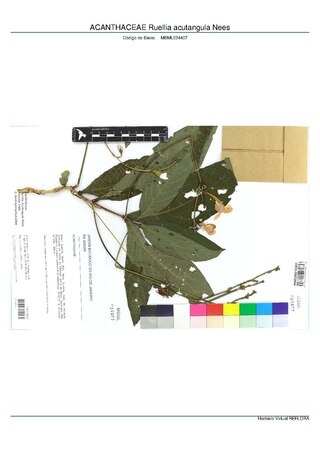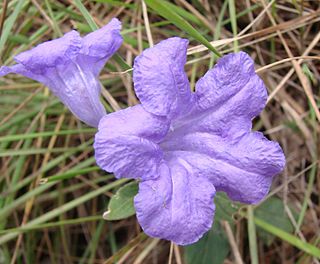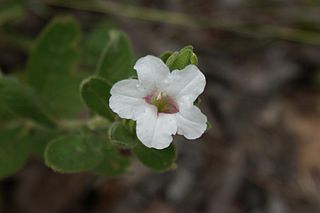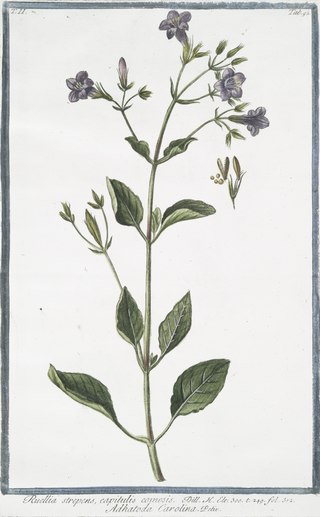
Acanthaceae is a family of dicotyledonous flowering plants containing almost 250 genera and about 2500 species. Most are tropical herbs, shrubs, or twining vines; some are epiphytes. Only a few species are distributed in temperate regions. The four main centres of distribution are Indonesia and Malaysia, Africa, Brazil, and Central America. Representatives of the family can be found in nearly every habitat, including dense or open forests, scrublands, wet fields and valleys, sea coast and marine areas, swamps, and mangrove forests.

Ruellia is a genus of flowering plants commonly known as ruellias or wild petunias. They are not closely related to petunias (Petunia) although both genera belong to the same euasterid clade. The genus was named in honor of Jean Ruelle (1474–1537), herbalist and physician to Francis I of France and translator of several works of Dioscorides.

Ruellia acutangula is a plant native to the Cerrado vegetation of Brazil.
Ruellia brevicaulis is a species of flowering plant native to Argentina, Brazil, and Paraguay. It is native to the Cerrado vegetation of Brazil.
Ruellia asperula is a medicinal plant native to eastern Brazil and growing in Caatinga vegetation and Cerrado vegetation. Flowers, leaves, and roots of this plant are usually macerated and used to treat asthma, bronchitis, fever, flu, and uteral inflammation.
Ruellia multifolia is a species of flowering plant in the family Acanthaceae. It is a perennial or subshrub native to west-central, southern, and southeastern Brazil, northeastern Argentina, and Paraguay.

Ruellia geminiflora, known locally as ipecacuanha-da-flor-roxa, is a species native to Argentina; Brazil, typically Caatinga and Cerrado vegetation; Guianas, and Venezuela. The roots of this plant contains possibly toxic substances.
Ruellia hapalotricha is a species of flowering plant native to the Cerrado vegetation of Brazil.
Ruellia eurycodon is a species of flowering plant native to the Cerrado ecoregion of west-central Brazil.

Mackaya neesiana is a plant species in the family Acanthaceae. It has various synonyms including Ruellia neesiana and Asystasiella neesiana. This species is cited in Journals of Travels in Assam, Burma, Bhootan, Afghanistan and The Neighbouring Countries by William Griffith under the synonym Ruellia neesiana.
Ruellia dissitifolia is a species of flowering plant in the family Acanthaceae. It is native to the Cerrado ecoregion of Brazil.

Ruellia nitens is a species of flowering plant native to the Cerrado vegetation of central and northeastern Brazil. This plant is cited in Flora Brasiliensis by Carl Friedrich Philipp von Martius.

Ruellia jussieuoides is a species of flowering plant in the family Acanthaceae. It is a subshrub of the tropical Americas, native to central and southern Mexico and Guatemala, Nicaragua, Costa, Rica, and Panama, and Ecuador, Peru, Bolivia, and West-Central and southeastern Brazil. It is native to the Cerrado ecoregion of Brazil.
Ruellia rufipila is a species of flowering plant native west-central Brazil, where it grows in the Cerrado ecoregion.

Ruellia macrantha, or Christmas pride, is a species of flowering plant native to the cerrado vegetation of Brazil. It is often used as an ornamental plant. This plant is cited in Flora Brasiliensis by Carl Friedrich Philipp von Martius.

Ruellia elegans is a species of flowering plant in the family Acanthaceae. It is a subshrub native to eastern and southern Brazil, where it grows in the Cerrado ecoregion.

Ruellia tuberosa, also known as minnieroot, fever root, snapdragon root and sheep potato, is a species of flowering plant in the family Acanthaceae. Its native range is in Central America but it has become naturalized in Africa, South and Southeast Asia.

Jean Ruel, also known as Jean Ruelle or Ioannes Ruellius in its Latinised form, was a French physician and botanist noted for the 1536 publication in Paris of De Natura Stirpium, a Renaissance treatise on botany.

Ruellia strepens, commonly known as limestone wild petunia, limestone ruellia, smooth wild petunia, or wild petunia is a species of flowering plant in the family Acanthaceae, native to warmer parts of the central and eastern United States. A perennial herb, it prefers to grow in moist to mesic, partly shady areas such as streamsides and bottomland forests. In the garden it is hardy to USDA zone 5, and can tolerate nearly full shade.











